Westminster is an infectious place. A tiny germ of controversy or rebellion can spread across parliament, through Whitehall and into the prime minister’s office within hours. The windowless offices are cramped, MPs sit elbow to elbow in a Commons chamber that can only squeeze just over 400 MPs into its seats, two-thirds of the number in parliament.
It is also a place of macho presenteeism, where the Greggs in Westminster tube station often serves as a nightly dinner spot for some of the most senior office-holders in the land.
This was the situation when Covid-19 arrived in the UK. The Guardian has spoken to a number of people who were there at the time. They revealed that the virus spread far more widely than has been reported, and spoke about the sense of panic across Whitehall as Covid threatened to paralyse government.
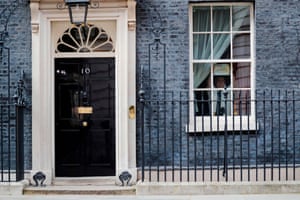
Horrified staff and ministers, dealing with the worst crisis in decades, had to reckon with how the country could be run when everyone in charge was getting ill.
Famously, Boris Johnson, Matt Hancock and Dominic Cummings contracted the virus. So did England’s chief medical officer, Prof Chris Whitty, and the then cabinet secretary, Mark Sedwill. Ministers and their staff had it. Almost all the staff in Downing Street, too.
It spread to special advisers across Whitehall and to parliamentary lobby journalists. Although the Palace of Westminster escaped any mass outbreaks among staff, several MPs caught Covid. Many in the office of the Labour leader, including Seumas Milne, had it. Jeremy Corbyn may have had it, although he was never tested and so has never been sure.
But the situation was at its worst at the heart of Downing Street. For a number of days aides looked almost entirely to the then director of communications, Lee Cain, for direction.
“No 10 was a plague pit,” one adviser recalls. “No one outside the postcode quite knows how bad it got in there.”
Another said: “Lee was running the country, genuinely, for quite some time.”
According to many of those present, almost the entire staff team in Downing Street caught Covid-19 at some point during those weeks, with James Slack, the prime minister’s spokesperson, a notable exception.
“You’d got to a meeting expecting to see someone important and they were gone – and you knew why,” another adviser said. “It started off more surreal than scary, but it became very scary once the PM was so ill.”
There are fewer workplaces less suited to social distancing than Westminster. High security means much business is conducted in person. MPs vote in packed and sweaty corridors. Staffers share desks. Most windows can only be heaved open a crack with brute force.
Downing Street is far from opulent when compared with the palaces of most heads of state. Staff use small entrances and corridors with flaking paint and decorated only with laminated health and safety notices. In the weeks leading up to lockdown, staff acknowledge there was no social distancing to speak of, only jokes about how to most respectfully sing God Save the Queen while hand-washing.
Staffers working in political and civil service roles during that time, who spoke on condition of anonymity as some are still in post, admit the pandemic took time to appear on the radar of a government preoccupied with a great election victory, Brexit and, closer to home, a purge of special advisers under Cummings’ iron fist.
There were concerns, but there was also a lightheartedness. One aide held a birthday party for fellow Tories and served Corona beer. Johnson was sufficiently unconcerned to miss five Cobra meetings in January and February. It seems clear the UK was deeply unprepared for the pandemic – from out-of-date PPE to delayed preparedness training – while contingency planning was diverted to a no-deal Brexit.
Lindsay Hoyle, the newly elected Speaker of the House of Commons, said the whole of government did not see until quite late the extent to which Covid-19 would radically alter everyone’s lives.
“I don’t think we got a picture [for a while] for how big of scale this was, or how it was going to affect the house. Like everybody else, we were underestimating how bad it was going to be. I’ll be very open, very honest about that. It was lack of understanding of what we were facing.”
One of the few people still working in a high-profile job in Westminster who had experience of tackling a pandemic was the shadow health secretary, Jonathan Ashworth.
“I was actually in Downing Street for swine flu 10 years ago,” the Labour MP said. “I remember when I first heard of the virus in Wuhan I thought: I wonder if that’s going to be like swine flu. But I obviously didn’t appreciate at that point it would be off the scale.”
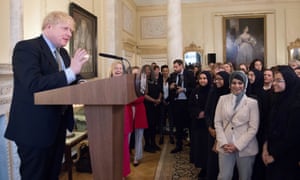
Ashworth asked for his first briefing with Whitty in January 2020. By February he was doing “nothing else” but studying the trajectory of the virus, he said. But it was when the health minister Nadine Dorries was confirmed to have Covid on 10 March that the magnitude of the crisis fully dawned on some of those in government.
“The moment we realised this is probably more widespread in the country than we thought is when Nadine Dorries tested positive,” one health official said.
At the time, people were only meant to get tested if they had been to one of the affected areas. “So the original assumption was, she hasn’t been to Italy or China so she hasn’t got Covid, even if she’s got some symptoms. And then she tested positive and I remember thinking: hang on, is this thing spreading much more widely than the people realise?”
On 11 March, the day after Dorries tested positive, Liverpool played Atlético Madrid in front of a crowd of tens of thousands at Anfield. It was also the day of Rishi Sunak’s first budget.
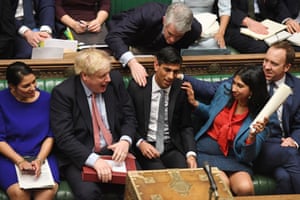
“Footage in the House of Commons for Rishi Sunak’s budget showed Tories slapping him on the back. It was a terrible look,” said Ashworth, who started advising staff to stay at home the week before lockdown. “[The government] should not have been doing that. I think there was definitely a feeling of British exceptionalism in Downing Street.”
Many of those at the heart of the story who caught the virus admit they were slow to realise how fast it was spreading. One special adviser recalled starting to experience symptoms in the middle of a meeting with a national newspaper’s political editor.

“Everyone was getting ill, it was quite striking how obvious it was,” one senior Labour official said.
“It felt like a cold,” said another senior party official. “And you wouldn’t normally go home because you had a slight cough. But then I was eating something and it tasted like metal. And the inside of my nose felt weird. And that’s when I realised.”
One political journalist who started feeling ill described being gripped by horror later in the afternoon when they remembered that the MP they had met earlier for coffee had breezily announced she was off to a meeting with her entire parliamentary party – and wondered how many they might have unwittingly infected.
“It was so different because it directly affected everyone, I got so many calls from journalists or MPs asking for personal advice, what happens if I’ve had dinner here or I’ve met this person, or if I’ve been to see my 80-year-old mother,” one health official said.
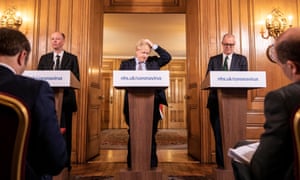

Photograph: Reuters
On 16 March, Johnson convened a meeting with Corbyn, Ashworth and staffers including Cummings and Milne, as well as Whitty, in Downing Street. It was intended to shore up Labour support for the coronavirus bill, introduced three days later. “Everyone was crowded around one desk,” one observer said. “It was insane if you think about it.”
The Labour group argued forcefully for more economic intervention, given the spontaneous lockdown many people in the country were already beginning to observe. Two sources in the room said Johnson agreed with Corbyn and Ashworth that some form of full national lockdown would be inevitable. The meeting was cordial; Milne and Johnson even shared a joke about their time as journalists.
The meeting’s significance might have been passed over had it not been for what followed.
Milne told friends he came down with a temperature that night – and was subsequently featured on the front page of the Mail on Sunday as the man who might have given the virus to the prime minister. Sources close to Corbyn said the then Labour leader also had some cold-like symptoms. Ashworth, who was also in the room, did not catch it.
No one can say for sure who spread Covid to whom, because the virus was already rampant in Westminster.
That evening Johnson advised people to avoid all unnecessary contact and travel and to stay away from pubs and theatres

On Wednesday 18 March, PMQs was quieter than usual but MPs still dribbled into the chamber. Sunak and Hancock, the health secretary, sat close to Johnson on the frontbench. Corbyn, despite being over 70, attended in person, with his spokesperson saying the government advice on shielding was still not clear.
On the Friday evening, Johnson said pubs and restaurants should close and Sunak announced a furlough scheme. On Monday 23 March, in a ministerial broadcast from Downing Street, Johnson ordered the entire nation to stay at home.
The first indication that officials outside Downing Street had that something was wrong with Johnson was a quiet inquiry by a No 10 special adviser to speak with Whitty on Wednesday. The chief medical officer advised the prime minister to get a test, which came back positive.
Hancock began experiencing symptoms on 26 March, and rang his staff to say he had a temperature and was getting tested, prompting panic in the department about how to handle the media frenzy they anticipated should they have to announce the health secretary was ill with coronavirus. But within hours the prime minister tested positive, and that was the story.
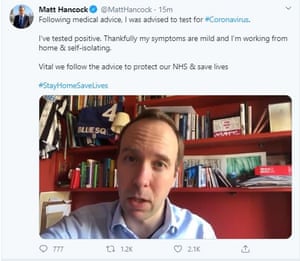
Johnson’s office realised in horror that one key person he might have infected was Hoyle, who has type 1 diabetes.
“I got a phone call immediately. They were very worried about me, because the footage on the television was Boris six inches away speaking to me. And Hancock had also done the same in the same week,” Hoyle said. “I was very lucky, I didn’t get infected, but nobody could have got closer to either of them. I don’t believe it was caught in the house. Far from it. My worry was about them bringing it into the house.”
Many of those staffers who fell ill like dominoes over the coming days tried to keep working. Hancock was isolating when he got a positive test but carried on issuing directions from home. “If anything he was almost more manic,” one official said.
Another senior party insider said they and many others just worked through the virus, taking short naps in between calls. “Even though I was ill, I’d worked every day from home for a week and I just used to get very tired in the afternoon and go to bed for two hours. And then I kept on working.”
“So much was happening by video and you could not always tell if people were at home because they were ill,” one aide said, describing it as “like playing wink murder” to spot who was trying to struggle through, or who was missing.
Whitty was forced into self-isolation by Johnson’s diagnosis, as were many other staffers. Cummings, Johnson’s all-seeing chief of staff, departed London for Durham with his young family, his wife already sick and knowing he was likely to develop the illness.
In the week after Johnson was diagnosed, it was not taken too seriously by staff, or the prime minister himself. He worked in isolation in Downing Street and would thump himself on the chest and say “strong as a bull!” and aides would laugh.
But it was quietly becoming evident it was taking him a long time to shake off the virus.

After making his daily joke, he would cough. Then cough for longer. Johnson was working in a small office connected by a stairwell to his No 11 flat next to another used by his private secretary and senior aides, who would toss paperwork and media scripts through the open door.
Johnson chaired cabinet on 28 March by video link, “coughing and spluttering his way through conference calls”, according to sources, which leaked into newspapers. Public questions were starting to be asked about the prime minister’s condition.
On Friday 3 April it was clear that Johnson’s symptoms were lingering and aides took a video in which an unkempt and clearly struggling prime minister said he “still has one of the symptoms, a minor symptom, I still have a temperature”.
The video was recorded on Johnson’s phone and took multiple different takes to record because he was coughing so much. Aides had to keep politely finding different ways to say: “I’m not sure we’ve quite nailed that there, boss.”
Even then, Johnson was joking about trying to look well on camera and “uplift the nation”. Many felt at the time – and more now do in hindsight – that more should have been done that week to persuade him to rest.
Advisers were getting worried. Discreet preparations were being made that week for Johnson’s admission to St Thomas’ hospital, should it be necessary. The Guardian got wind of this but it was denied by officials.
By Sunday, it was necessary. Johnson phoned his senior staff before he left for hospital confirming Dominic Raab, the foreign secretary, should take charge in his absence. Cummings was also out of the picture, ill in Durham.
“It wasn’t actually scary – personally scary – until the PM almost died,” one senior official said. “From that moment you go from it being just a manic effort to get everything done to the consequences of it all hitting you so hard.”
There was still a persistent attempt, outwardly, to pretend Johnson remained in charge. At the daily press briefing on Monday 6 April, Raab kept repeating that the prime minister was in “good spirits”. In fact, neither was true.
That night Johnson was moved to ICU. He had told the nation he hoped to turn the tide in 12 weeks and that restrictions would be reviewed in three weeks. In that third week, he was in intensive care.
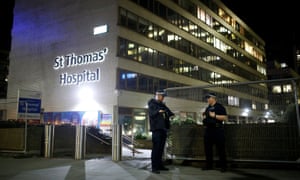

The symbolism was not lost on many working closely with him. Johnson’s private secretary, Martin Reynolds, phoned Downing Street and said there was a “50/50” chance the prime minister would be put on a ventilator. If this had happened, his chances of survival would have plummeted. Sedwill was in charge of drawing up a plan for succession if Johnson died – approved by the prime minister himself.
No 10 at that point was like “a ghost ship”, as one aide put it. Cummings was in Durham, Cain was on his last day of self-isolation.
“Lee came in like a bullet the next day,” one colleague recalls. “There was a meeting he turned up to with Raab, Sedwill and other civil servants and he was like: ‘Hello, I’m back, I’m in charge of the politics now.’”
The political staff in No 10, particularly those with a background in Conservative internecine politics, were also starting to think about the nightmare scenario of the death of the prime minister. “You knew the party would have forced some awful leadership election, it would have been carnage,” one said. “It was about confronting the utter horror of that – in a pandemic – and feeling pretty overwhelmed with emotion, too.”
Representing one of the flaws of the British political system, Downing Street resembles the court of a medieval king. What matters is the prime minister, and who matters are those who have the ear of the prime minister. Advisers fall in and out of favour and only a few are known to be directly speaking for the prime minister – those who can therefore be taken seriously. When the prime minister is suddenly absent, the system no longer works.
“There’s a gap, like physically, in the building, and there was a bit of a gap politically,” one former adviser said.
“The two main characters – Johnson and Cummings – were absent,” one No 10 insider said.
“When the court doesn’t have a king, it’s just a massive vacuum,” another former staffer said. “The only reason senior people had authority is because they spoke with his voice. So when you remove him, it becomes very, very difficult to keep that authority.”
“Boris in particular, his presence is really felt, he takes up space,” another ex-staffer said. “And the other person who had that presence was Dom. And he was gone as well.”
“That week was hell,” another official said. “There were all these meetings where it was never completely clear who was driving things or in charge. Who was actually going to be there if you had a meeting?”
Those who recovered were desperate to get back into work. “I remember saying I have to be there, I’m going mad at home,” a Whitehall source said. At the time, civil servants were ordered to work from home but many in No 10 wanted to be in the building. Cain told them they could come in if they wanted and he would take the flak.
“Lee did end up running the country for about two weeks, I’d say,” one adviser said. “There was no one else any sort of senior level who had any sort of authority on behalf of the PM to be doing stuff or making decisions.”
Ministers’ aides were buddied up and told to get to grips with a different department so they could shadow each other if another fell sick.
Cain had been at the prime minister’s side for years, through his time at Vote Leave, to the Foreign Office, to his time on the backbenches and through his leadership campaign. Even more than Cummings, Cain was seen by people in Whitehall as speaking with his boss’s voice. “It was a bit like a very long marriage,” one close friend said.
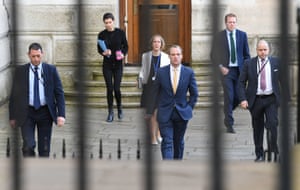
Raab, the “designated survivor”, as he was nicknamed, took charge of the day-to-day business as part of a quad of ministers with Sunak, Hancock and Michael Gove. Hancock was often the target in those meetings as the government struggled with PPE shortages, deep concerns over ventilator capacity and what many felt were wildly optimistic promises by the health secretary on testing.
Raab felt his role was to be a stabilising force, one aide said. “He was a good manager, he didn’t push his own agenda. It was just a holding position. But he didn’t step up in the way Rishi stepped up. You’d hardly say it was a moment for Dom Raab.”
Others described Raab’s understated attitude to the role as a strength. “He had a lot of big jostling egos to manage in the cabinet and he managed it,” an aide said.
A senior Downing Street source said it was like “chalk and cheese” working with Raab versus working with Johnson. The prime minister would hand out jobs from his red box, happy to delegate – “a bit more loosey-goosey” as one insider put it. Raab was extremely strict with protocol and insisted everything went through Cain.
In the prime minister’s absence, battle lines were also starting to be drawn between those who believed opening the economy was imperative and those who believed a long lockdown was necessary.
Cummings spent much of his isolation reading about the Spanish flu pandemic and told advisers after he returned that he had been convinced of the need for tougher measures and slower reopenings. There was some political calculation at play as well: Cain and the Tory adviser Isaac Levido believed the party would be annihilated at the next election if there was a catastrophic death toll, whereas voters would be more forgiving of economic turmoil.
Among those in favour of “running in hot”, which one characterised as “trying to allow desperate business owners to salvage their livelihoods”, were Sunak and the prime minister’s chief of staff, Edward Lister, who was shielding at home for much of the period. Newspapers were constantly briefed about the rows between “doves and hawks”.
Gove was someone who “jumped from one camp to the other”, one adviser said, though in latter months he has been a more predictable voice of caution, alongside Hancock. In those early weeks, it was drily observed in Whitehall that Gove always seemed to be characterised as a hawk, whatever his position.
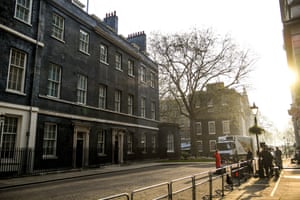
No 10 and Whitehall were beset by leaks during that period, on the very biggest issues. “It’s fucking Zoom,” a special adviser said. “You’d log on to a sensitive meeting and you think it’s going to be five key people and then you’re like, hang on, why are there 80 people here and who the hell are they? We may as well broadcast this thing live to the world.”
The daily 9.15am call between Raab, Sunak, Gove and Hancock would constantly leak. “Rish just got to the point where he wouldn’t even say anything in the meeting,” one insider said.
With Johnson temporarily out of the picture, political aides suggested there were some attempts by ministers or civil servants to quietly discard unpopular issues. An adviser recalls a suggestion that a legal signoff connected with HS2 was needed – and that it be delayed until the prime minister’s return. “One of the first things the PM said when he got back was: ‘I can’t believe they tried to delay HS2 while I was in the ICU.’”
“People really pushed their luck during that time – cabinet ministers, civil servants,” a senior aide said. “People delivered statements for approval by No 10 just 10 minutes before they were supposed to deliver them at the press conference and we had to be like: hang the fuck on!”
All the actions of staff during that period are likely to be the subject of a public inquiry – perhaps the most important undertaking in living memory. Many believe the mistakes that were made were not a direct result of the way the virus ripped through the heart of Westminster and hobbled the operations of the government, but predictable consequences of a decade of deliberate policy.
“I wasn’t in government. So I don’t know the extent that people being off ill hindered the decision-making on a day-to-day basis,” Ashworth said. “But the reason our response has been so disappointing and why we’ve been so exposed is because of decisions made over many years. The absolute scandal about the way in which we allowed the virus to rip through social care, not giving their staff sick pay, which meant that staff had to go to work.
“We’ve built an economy which is characterised by zero-hours contracts, temporary work. These are all a reflection of the type of economy that the Tories have built over the last 10 years.”
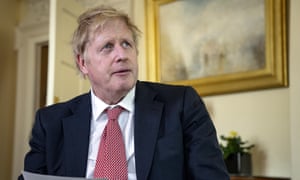
Johnson returned to Downing Street on 12 April to a team that felt “overwhelmed with relief”, according to one staffer. He went to recuperate with his pregnant fiancee, Carrie Symonds, who was also recovering from the virus.
But any reprieve would be very short-lived. The day he returned was the same day Cummings set out for his drive to Barnard Castle.
